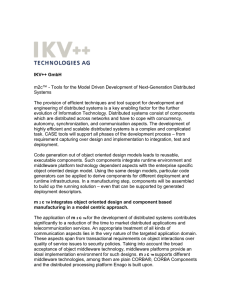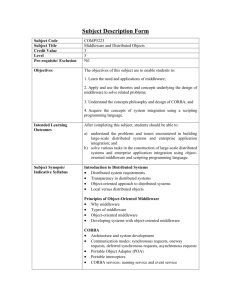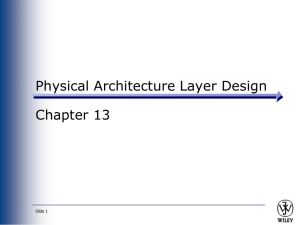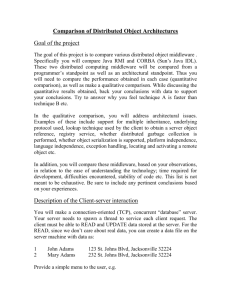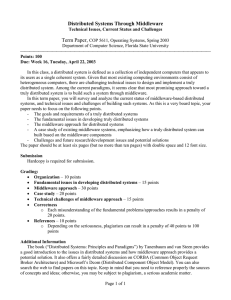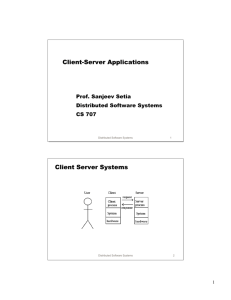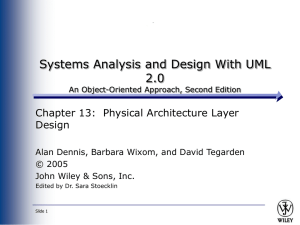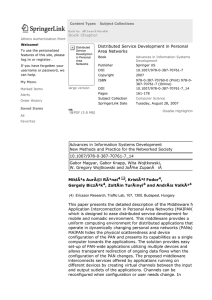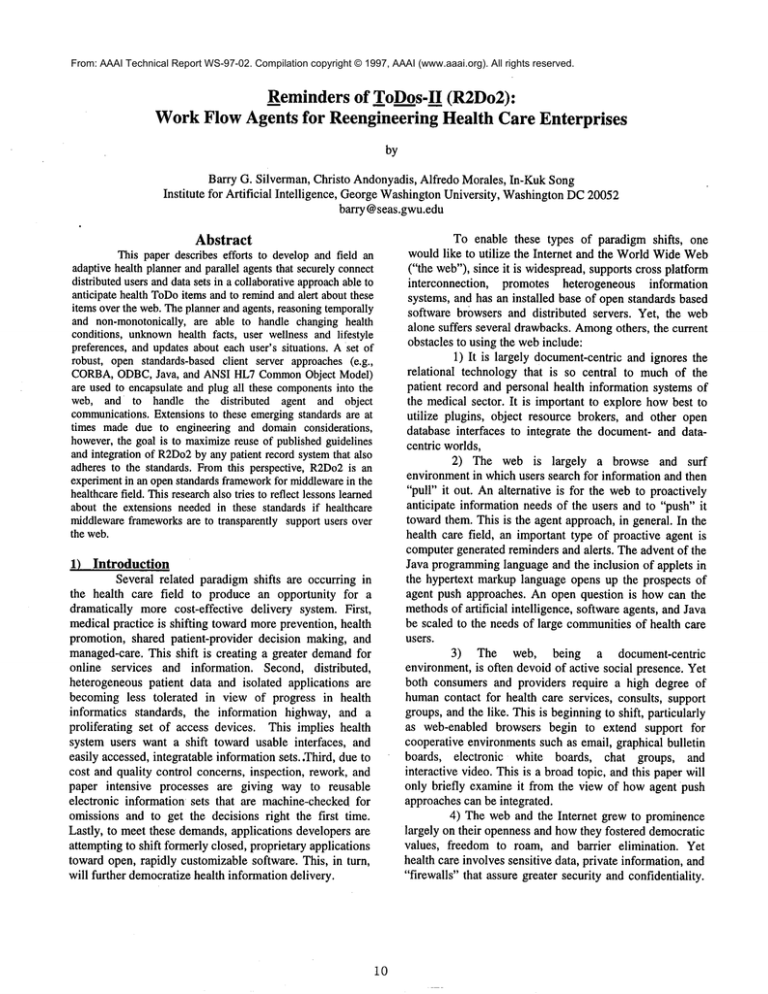
From: AAAI Technical Report WS-97-02. Compilation copyright © 1997, AAAI (www.aaai.org). All rights reserved.
Reminders of ToDos-II (R2Do2):
WorkFlow Agents for Reengineering Health Care Enterprises
by
Barry G. Silverman, Christo Andonyadis,Alfredo Morales, In-Kuk Song
Institute for Artificial Intelligence, GeorgeWashingtonUniversity, WashingtonDC20052
barry @seas.gwu.edu
Abstract
This paper describes efforts to developand field an
adaptivehealth plannerand parallel agents that securelyconnect
distributedusers anddata sets in a collaborativeapproachable to
anticipate health ToDo
items and to remindand alert aboutthese
items overthe web.Theplannerand agents, reasoningtemporally
and non-monotonically, are able to handle changing health
conditions, unknown
health facts, user wellness and lifestyle
preferences, and updatesabout each user’s situations. A set of
robust, open standards-basedclient server approaches(e.g.,
CORBA,ODBC,Java, and ANSIHL7Common
Object Model)
are used to encapsulate and plug all these components
into the
web, and to handle the distributed agent and object
communications.
Extensionsto these emergingstandards are at
times madedue to engineering and domainconsiderations,
however,the goal is to maximizereuse of publishedguidelines
and integration of R2Do2
by any patient record systemthat also
adheres to the standards. Fromthis perspective, R2Do2is an
experimentin an openstandardsframework
for middleware
in the
healthcarefield. Thisresearchalso tries to reflect lessonslearned
about the extensions neededin these standards if healthcare
middlewareframeworksare to transparently support users over
the web.
1) Introduction
Several related paradigmshifts are occurring in
the health care field to produce an opportunity for a
dramatically more cost-effective delivery system. First,
medical practice is shifting toward moreprevention, health
promotion, shared patient-provider decision making, and
managed-care. This shift is creating a greater demandfor
online services and information. Second, distributed,
heterogeneous patient data and isolated applications are
becoming less tolerated in view of progress in health
informatics standards, the information highway, and a
proliferating set of access devices. This implies health
system users want a shift toward usable interfaces, and
easily accessed, integratable informationsets..Third, due to
cost and quality control concerns, inspection, rework, and
paper intensive processes are giving way to reusable
electronic information sets that are machine-checkedfor
omissions and to get the decisions right the first time.
Lastly, to meet these demands,applications developers are
attemptingto shift formerly closed, proprietary applications
toward open, rapidly customizable software. This, in turn,
will further democratizehealth information delivery.
10
To enable these types of paradigm shifts, one
wouldlike to utilize the Internet and the WorldWideWeb
("the web"), since it is widespread,supports cross platform
interconnection, promotes heterogeneous information
systems, and has an installed base of open standards based
software browsers and distributed servers. Yet, the web
alone suffers several drawbacks. Among
others, the current
obstacles to using the webinclude:
1) It is largely document-centricand ignores the
relational technology that is so central to muchof the
patient record and personal health information systems of
the medical sector. It is important to explore howbest to
utilize plugins, object resource brokers, and other open
database interfaces to integrate the document-and datacentric worlds,
2) The web is largely a browse and surf
environmentin which users search for information and then
"pull" it out. Analternative is for the webto proactively
anticipate information needs of the users and to "push" it
towardthem. This is the agent approach, in general. In the
health care field, an important type of proactive agent is
computergenerated reminders and alerts. The advent of the
Java programminglanguage and the inclusion of applets in
the hypertext markup language opens up the prospects of
agent push approaches. An open question is how can the
methodsof artificial intelligence, software agents, and Java
be scaled to the needs of large communitiesof health care
users.
3) The web, being a document-centric
environment,is often devoid of active social presence. Yet
both consumers and providers require a high degree of
humancontact for health care services, consults, support
groups, and the like. This is beginningto shift, particularly
as web-enabled browsers begin to extend support for
cooperative environmentssuch as email, graphical bulletin
boards, electronic white boards, chat groups, and
interactive video. This is a broadtopic, and this paper will
only briefly examineit from the view of how agent push
approachescan be integrated.
4) The web and the Internet grew to prominence
largely on their openness and howthey fostered democratic
values, freedom to roam, and barrier elimination. Yet
health care involves sensitive data, private information, and
"firewalls" that assure greater security and confidentiality.
The latter must be incorporated while sacrificing as little of
the formeras possible.
Given the paradigmshifts in health care, progress
is neededto reduce each of these four sets of obstacles. At
present they present a collective challenge to any healthrelated project, and this article reviews howone project is
trying to address them with particular emphasison 1 and 2.
Specifically, this paper describes a reusable intelligent
agent project that seeks to unify the data- and documentcentric views and to provide a push approach in a
collaborative and secure environment. This agent approach
is being built with open standards-oriented technologythat
is maturing at present, but is expected to be widely
implementedin the near future.
The system we are developing, called Reminders
of ToDos-II (R2Do2), offers a model for how to meet the
four challenges in the area of health care planning in
general, and for remindersand alerts, in particular. Medical
reminder and alert systems organize and display machinetriggered ToDoitems, reminders, and alerts. Studies show
these machinegenerated reminders and alerts significantly
increase
performance of clinicians
as well as
consumers/patients, and if widely deployed they hold the
potential to save the health industry billions of dollars
annually through better disease/error prevention and health
promotion(Shea et al. 1996) (Einarson 1993). In the health
care arena, this approachalso holds the ability to empower
consumersto better managetheir ownwellness efforts, and
to enable clinicians to reduce omissions and unintended
medical errors: Safran &Rind (1996). Further, it should
enhance communicationsand collaboration between health
care consumersand providers. More generally, this paper
illustrates an approach to adaptive planning for personal
assistant agents.
This article reviews these innovations and
identifies
how R2Do2serves as a model for further
unification efforts. Specifically, Section 2 presents the
architectural view of R2Do2and shows howthe four webrelated challenges are addressed for both institutional and
personal versions of R2Do2. This raises a number of
challenges for scaling the AI algorithms and agents and for
incorporating numerousopen software and data standards
as are discussed in the next two sections of the article,
including the adaptive planner (Section 3), and the
temporal reasoning, reminder agents (Section 4). Finally,
Section 5 returns to the topics of the Introduction with
lessons learned and future research needs.
1.1) Healthcare Guideline Agents
The idea is not new of online alerting and
reminding from electronic practice guidelines able to
interact with a medical record and with providers’ orders.
Early examples may be found in McDonald(1976) and
Warner(1972), while more current examplesare described
in Musenet al. (1996), Safran &Rind (1996), Shea et
11
(1996), and manyothers. However,for a variety of reasons,
very few of these systems have madeit out of the academic
center, hospital, or clinic where their developers have
piloted and tested them.
The major obstacles to portability seem to be
severalfold: (1) the reminder methodsand engines are not
generic, but are written in a variety of languages and
according to arbitrary, undocumentedstandards so that the
code is difficult to modifyand maintain; (2) the reminder
methods and engines are hard-wired to "legacy" or
institution-specific record systems with local lexicons and
interface code; (3) the user or screen interfaces are
similarly hard-wired and non-standard; (4) the guideline
KBsare specific to the homeinstitution that authored them
and maynot be desired by others without modification; and
(5) the programmerswho created the code are frequently
unavailableto modifyit later.
Somevendors offer new, turnkey patient record
systems that try to overcomesuch obstacles. For example,
Healthpoint ACS(anon. 1996) is a patient record system
for small private practices that includes an integrated
modulethat scans all prescription orders against other
drugs on the patient’s medicationlist as well as against the
patient allergy list. Right out of the box, its conditions
rulebase reminds the user when contra-indications and
adverse interaction effects will arise. Onecan add to or edit
these rulebases to make them institution-appropriate.
Unfortunately, such vendor-specific
systems are a
necessary, but not sufficient,
step to overcome the
obstacles. This is because most information systems
already exist, and they won’t easily be converted to a given
vendor’s implementation,nor do their institutions wish to
do so.
Another answer is to connect applications to
middleware so that others mayview the application as a
component that they may embed and or plug in by also
connecting to the. middleware. One manual approach to
this is where componentor object vendors have taken to
"wrapping" legacy information systems and adding their
applications via integration interfaces. An example is
MultumInc’s MediSourceexpert system for drug therapy
and order-entry (Schrier 1994). Originally a stand-alone
expert system, MediSourcenowoffers a consulting service
that manuallyembedstheir software as an agent obtaining
order entries from the legacy system records, and
submitting its alerts to the clinician through the familiar
legacy interface. This is a solution that could be duplicated
with practice guideline knowledgebases (rather than just
drug therapy), however,it fails the test of open standardsbased software, and is once again vendor-dependent. This
solution does not scale well or quickly when trying to
expand to each new site in a given healthcare community,
whenadding other potential knowledgebases or agents, or
when extending over the distributed,
longitudinal,
heterogeneous"record."
The alternative pursued by R2Do2is to build
towards a middleware architecture,
called HOLON
(Silverman et al., 1996), that adopts interoperability and
open-softwarestandards. R2Do2is a test application of the
HOLONproject meaning both R2Do2 and HOLONare
being evolved in parallel.
HOLON
uses a three tier
middlewarearchitecture. This idea is an "any-any" model
to connect any client to any database system via an openstandards middleware component. An editable/extendable
reminder/alert agent such as R2Do2can plug into this
middle tier. Specifically, to integrate guideline agent
capabilities (or other applications) with legacy systems via
a three tier approach, HOLON
is using:
¯
a semantically rich, open, object-oriented, standard for
specifying and accessing heterogeneous, longitudinal,
distributed information (It is not intended to provide
new information, nor to replace existing information
standards as far as they go, only to adopt an open,
standards-based meta-modelwhere others can plug in
their datasets and applications. To do this we explore
the HL7 messaging standard as an object oriented
modelof the clinical data repository, and extend it at
the information content level via use of ICD9 and 10
codes, amongmanyother content standards),
¯ the wrapper, lexicon translation, vocabulary server,
and integration engine capabilities to query/manipulate
and plug-together new and legacy systems,
¯ traditional
middleware
services
such as
communications,transport, security, messagequeuing,
etc., as well as emerging standards for application
mobility and object brokering (ew.g., CORBA,
OLE),
and
The "middleware" field partially addresses many
of these items: (Bernstein 1996), (Lewis 1995). Yet sectorand industry-specific frameworkssitting abovetraditional
middlewareare also being developed to complete this list
and to open up the full agent potential. In the health care
sector, a number of standards bodies and consortia are
workingin these directions: (Fitzmaurice 1994), (Halloran
et al. 1996), and (Rischel 1’996). Our research investigates
howa reminder engine can exploit someof these advances.
In this way R2Do2,sitting atop HOLON,
is a model of a
middleware framework for the healthcare field (i.e.,
vertical facility in CORBA
terms).
This is a point also madeby Musenet a1.(1996)
their EONsystem. EONis an environment for authoring
electronic protocols and connecting them to patient record
systems so as to automate the recommendingof therapeutic
interventions. Musenet al. repeat the point that crossindustry middleware frameworks like CORBA
and OLE
are vital advances. Yet "for clinical software to be reusable
and maintainable in a proficient manner, higher level
software abstractions are necessary..." to promote the
12
clinical-specific
middleware field. R2Do2shares that
objective of a more healthcare oriented middleware
frameworkwith EON,however, there appear to be several
differences between the two systems: (1) EONseems to
oriented towardsupporting a user at a clinical workstation,
whereas R2Do2is concerned with supporting a distributed
group of users; (2) EONseems to focus on clinical
recommendations, whereas R2DO2
covers both the clinical
and consumer perspectives; (3) EONoffers fine-grained
recommendationsfor both the diagnostic and care tasks,
whereas R2Do2to date provides only coarse-grained
support for prevention and wellness promotion tasks; (4)
there are internal algorithmic differences for accomplishing
roughly equivalent clinical tasks such as the heuristic
propose-revise-plan algorithm of EONas comparedto the
nonmonotonic, adaptive argumentation logic of R2Do2;
and (5) EONprovides a robust frameworkthat middleware
standards need to be connected to, whereas R2Do2is
currently attempting to conformwith and utilize a number
of middleware standards such as CORBA,HTTP, IIOP,
Arden, HL7,and the like. Thesedifferences reflect the fact
that no single frameworkis sufficient to address the entire
field of middleware for healthcare, and that multiple
frameworks should be encouraged. However, it is
important that all the healthcare middlewareframeworks
be integratable if application users are to makeuse of them
all.
2) The R2Do2 System
The R2Do2arhitecture makes use of several
principles of modernsoftware engineering such as objectoriented design (in its modules, communications, and
databases), open software standards, portability of
interfaces, and three tier client-server configuration. In
Figure 1 one can see multiple clients on the left, the servers
on the right (and bottom), and middlewareconnecting the
two. Before we discuss the details of Figure 1, several
items are worthpointing out. First, this architecture avoids
the "stovepipe effect" or closed, proprietary, non-portable
interfaces and databases found in muchlegacy software in
the health care field. Bycontrast, the architecture of Figure
1 permits virtually any vendor’s hardwareto be seamiessly
substituted for either the client or server stations. R2Do2
is
platform independent. Likewise, any legacy patient record
system is potentially connectable once the wrapping is
effected. In the same vein, browsers, collaborative
environments, personal information managers,and the like
can be readily substituted just by registering themwith the
commonobject services. Finally, the humannotification
process is not limited to computerclients, but is extensible
to pagers, interactive TV, fax, voice synthesis, and other
forms of remindingand alerting.
Fieure 1 - Architecture of R2Do2ShowingIts Use of HOLON’s
Three Tier "Client-Middleware-Content Server" Model
Paging
Sorvim
Provide"
PagingPropielaryProtocol
SMTP
I
~mtdlReader
¯ ToDo
ItaTis
¯ ,k~,amatted
WebBrowser
¯ ToD~Browser
oQuastionn~
ras
Common
Object ~’vloM
R2DO2
Sat vet
Gateway
Service
¯ Ra~ner
,HTTPD
¯ Multi RemindAgentsolIOP
TSRAIwt~
¯ ~,na~l
Parse¯ M~ Analyser
,GUI
LEGEND
BIDMC
- BethIsrael Deaconess
M~d,Center
CORBA
- Common
ObjectRequest
Broker
H’rrPDHyper
TextTransfer
Protocol
Daemon
IDL- InterfaceDefinitionLanguage
IIOP- InternetInterORB
Protocol
JDBC
- JavaDataBaseConnectivity
OO- ObjectOriented
ORB
- ObjectRczluestBroker
ODBC
- OpenDataBaseConnectivity
RDBS
- RelationalDatabase
System
\
SMTP
- SimpleTransferMallProtocol
SQL- StructuredQueryLanguage
Ccmmunlcetlon
Coordinator
q~l~ll
Secuclty
.Pager
,LDAP
*ServerSockets .VolceMell
.F~
ORB
DataSir ver
°OOL~yer
°LogicalDBs
*Active Methods
¯ ExecuteQueries
¯Return
results
°Execute
Querlas
¯ Return
r~ults
Oracle
MS-SQL
RDBS
Xybasc
LegacyBIDMC ~
DBS
Returningto the details of Figure 1, there are
six major modules that warrant discussion: clients,
groupware, middleware ORBs, middleware services,
reminder server, and data server. Perhaps more
important than any module, though, are the users who
consist of healthcare consumersand providers, each of
whomhave differing needs from the modules. Wewill
mention these range of needs and how they are
supported in the discussion of the modules.
Clients -- Theinitial client design target is a
desktop PC, although our consortium also requires
interactive TVand beeper service. The client includes
(see Figure 2) a web browser, web-enabled email
viewer, and a terminal stay-resident (TSR) alerter
componentthat parses email and alerts users whenhigh
priority health items have arrived. The webbrowser is
the main route through which applets elicit "user
preferences" for health plans, recurring ToDoitems,
and reminder schemes, and through which the database
is browsed. The email viewer is the primary place for
receiving and perusing ToDoitem reminders and for
13
altering their settings, forwardingthemto others, and so
on. All three elementsof the client makeuse of the Java
virtual machine for executing applet bytecodes, and
thereby maximize platform independence, multithreading, and security of local resources.
Groupware
-- R2Do2explicitly incorporates
an email router with a forward and CClist for relevant
consumers, providers, and surrogate caregivers. Also,
R2Do2can be incorporated into any open standard
groupware environment, such as a web browser that
recognizes CORBA
and Java applets. Thus it can be
used alongside whiteboards, chat spaces, and videoconferencingfacilities as in a test-bed currently being
deployed at numerous homes, clinics, Beth IsraelDeaconess Medical Center in Boston and Norwalk
Hospital, Connecticut( e.g., see Silverman1996).
MiddlewareORBs-- Rather than connecting
to servers, the clients connectinstead to openstandards
middleware, or more specifically via HTTPand the
Internet to Object Resource Brokers (ORBs). The
ORBseffectively encapsulate the various client and
server modules, and turn them into object-like
componentsthat can messageeach other transparently,
through a commonobject model. At present, R2Do2
subscribes to the model of the Common
Object Request
Broker Architecture (CORBA),an industry sponsored
standard (e.g., see Otte et al., 1996). Weuse the ORB
from Visigenic, Inc. a subsidiary of NetscapeCorp.
Figure 2 - R2Do2Event Browser Screen
File
Edit
~iew
Go Bookmarks
Options
Oirectory
Window Help
To Do List
S
1
M T
2 3
96 Dee
W T
4
5
F
6
S
7
14
21
1851961710 1811~
22 23 24 25 26 27 28
29 30 31
Middleware Services -- Along with the
CORBA
standard comes a set of run-time library-like
services. Newusers are registered with these services to
provide Master Patient-Member Indexes; security
authorization, access, and authentication information;
and notification alternatives. In the personal version of
R2Do2,manyof these services are omitted, while those
that remainare automated.In the institutional version,
this activity is partially supportedby applets collecting
data from users, but is highly dependent on a system
administrator to verify, update, and maintain the
various registrations.
Data Server -- This server contains
computerized patient records, personal health
information not normally in patient records, and PIM
type activity information generated by the consumer
from their screen. The persistent store is, in effect, a
dynamic model of the consumer’s health status and
activities that is jointly maintainedby the consumerand
by health care providers. Wehave deployed an object
layer sitting at the top of the persistent store that
monitors the input streams, detects trigger conditions
(e.g., users whoserecords have been updated since the
last broadcast), and transmits these items to the
planning componentand reactive agents.
14
In practice, connecting institutions to R2Do2
is a non-trivial task due to cross-institution guideline
differences, lexical and semantic ambiguities in diverse
patient record terminologies, and legacy storage system
wrappingand translating constraints. Weare currently
in the second of a three year project in which a nonprofit consortium is piloting more generic ways to
connect and wrap such institutional resources including
use of the ANSIhealthcare data model, open database
connect (ODBC)standard, and the UMLSvocabulary
server: Silverman(1996).
ReminderServer -- The classical definition
of a planner is a programthat generates a sequence of
actions (the plan) that will movean entity from its
initial to its goal state. Aplan is first generatedand then
sent to an execution agent to carry out each of the
(ToDo) actions.
A number of researchers
have
extended this approach so it responds to a dynamic,
uncertain environmentwhere the initial plan mayneed
to be revised before execution is completed: e.g., see
Haddawy(1996), Lyons & Hendriks (1992), among
others. These approaches differ in terms of, among
other things, varying degrees of world knowledgein
their planner’s
model of the environment,
sophistication of adaptive reasoning, and degree of
separation of sensor, planner and effector. The best way
to handle these and other differences are open
questions.
In our case R2Do2adopts a framework for
organizing the distributed reasoning and processing
elements. The frameworksettled on here has 5 steps
that R2Do2continually strives to solve. The steps push
the systemto:
1.maximize consumer health by recommending
preventionand care plans for each situation that arises
2.mine the consumerhealth files with the help of a
Java version of the CLIPSforward chaining engine and
a set of guidelines KBsin order to discover situations
requiring action and to construct the plan of recurring
ToDoitems for each consumer
3.mapthe recurring plan elements (ToDoitems) onto
the consumer’s (and provider’s) schedule and launch
agents to help carry out the scheduled.plans, subject to
user wishes.
4.utilize personal assistant agents to isolate and carry
out a user-acceptable schemeto notify and remind the
consumersof the ToDoitems likely to maximizetheir
health
5.alert providers and surrogate caregivers when
consumersseriously deviate fromthe plan to their selfdetriment.
In R2Do2’s framework (see Figure 1), the
Planner generates a number of ToDoitems for each
consumerand provider registered in the environment.
Numerousplan intervals and actions may need to be
generated at various times during the year for each
user. Once new or updated plans are completed, the
agents are launched and are given both personal
assistance and limited self-planning capabilities. These
capabilities allow the agents to react directly with users
and with the client servers. Thus agents can conserve
resources by putting themselves to sleep until needed;
alter their reminding schemes in response to user
preference; postpone, cancel, or re-assign ToDoitems
and reminders also upon user request; coordinate
alternate modesof communication(e.g., TSRalerter,
email, and beeper); and contact providers and inform
surrogate care givers when critical ToDoitems are
neglected.
Via the "user request" mode, the users may
alter their plan directly (e.g., snooze,cancel, or reassign
an item). Also, users can add new ToDoitems either
directly through applet screens, or indirectly via their
answersto health profile and preference questionnaires.
In this mannerR2Do2derives an initial health
plan that it continually refines and adapts as the users
age, change their practices, develop new conditions,
and so on. As new, or sometimes unexpected events
occur (e.g., a miscarriage, a diabetic complication,
reaching the next birthday, etc.) the original plans will
need to be revised anew, and the agents carrying them
out, modifiedyet again.
3) Empirical Findings
Over the past year, we have built several
prototypes and two versions of R2Do2.At present we
have both a personal version available through a web
browser interface, and an institutional version being
piloted at the Beth Israel-Deaconness Medical Center.
Weexplore the results to date and lessons learned in
the subsections that follow.
4) Lessons Learned
This paper described efforts to develop and
field an adaptive health planner and parallel agents that
securely connect distributed users and data sets in a
collaborative approach able to anticipate health ToDo
items and to remindand alert about these items over the
web. The planner and agents, reasoning temporally and
non-monotonically, are able to handle changing health
conditions, unknownhealth facts, user wellness and
lifestyle preferences, and updates about each user’s
situations. Usageof and extensions to argumentation,
qualitative decision making, situational calculus, and
temporal algebras are described. Defeasible assertions,
default arguments, support sign dictionaries, closed
world assumptions, and anytime algorithms are used to
derive feasible health plans that are later updated as
more information unfolds. A set of robust, open
15
standards-based client server approaches (e.g.,
HOLON, CORBA, ODBC, Java, and ANSI I-IL7
CommonObject Model) are used to encapsulate and
plug all these componentsinto the web, and to handle
the distributed agent and object communications.
Extensions to these emerging standards are at times
made due to engineering and domain considerations,
however, the goal is to maximize reuse of the
guidelines by any patient record system that adheres to
the standards.
At the start of this paper, four challenges to
web-basedapplications were introduced that we return
to in the next four subsections.
4.1) Merging Data with Document-Centric
ComDutine
Web pages with their hyper-text markup
language (HTML)are a document-centric mode
computingthat has revolutionized usage of computers.
In R2Do2,guideline KBs, questionnaires, preference
elicitation screens, and ToDoitem messagesand advice
utilize this documentmodality. In trying to extend this
approachto the data-centric side of health information
management
systems, several difficulties arise that are
not easily overcome.These difficulties center around
the collection, storage, retrieval, and maintenanceof
each user’s health information and situations, what is
earlier defined as Fi. For a newuser, the Fi is a large
set of questions to answer. This is often called the
health profile or patient interview, and it mayinvolve
collecting hundredsof answers. Ideally, one wouldlike
to use a question engine that can branch over interview
rules and collect those answersmost relevant to a given
user’s health situation. Unfortunately, the webstandard
inhibits reaching such an ideal if one seeks to adhere to
HTML
standards such as cgi forms and Java virtual
machines. For example, one cannot downloadthe Java
inference engine and run it within an applet since local
memoryresources cannot be written to. Waiting for the
engine to read and write assertions on a remoteclient is
impractical. Likewise downloadinga plugin interview
system can be discouraging to users. The simplest
alternative is to use fixed questionnaires about each
health area and situation, and to stream these to the user
as cgi forms or Java applets. This meansthat Fi are
collected in a more exhausting, less user-sensitive
mannerthan one wouldlike. As a result, critical Fi may
remain unanswered longer than would otherwise be
necessary.
At the start of this paper, several paradigm
shifts in the health care field were mentioned, one of
which was the idea of empoweringusers by connecting
them to access and managetheir ownhealth data. Using
the web browser, Internet Inter-ORBProtocol (IIOP),
an ORB bus, and the ODBCstandard
we have
demonstratedthat this is feasible, as haveothers before
us through comparably open standards (e.g., as did
Kohaneet al., 1996 with HTTP). However, there are
numerous, serious problems to this approach. Here we
will concentrate on the connectivity problems, while
subsequent paragraphs will address programmingand
security aspects. The connectivity problemsstraddle the
syntactic and semantic levels. At the syntactic level,
there is the basic problem of connecting the "pipes."
The main obstacle to point out here is that the CORBA
standard has not yet matured to the point needed. In
particular, the ORBservices include, amongothers, a
trader, a nameserver and a database query server. The
nameserver standard, however, is still underspecified
so that it is not possible to locate a given patient and
their records -- that is being addressedas of this writing
by request for proposals for a master patient index
standard by the CORBAmed
committee. The query
server standard within CORBA
was adopted in the
summerof 1996, but that standard in turn adheres to
the SQL3and Object Query Language (OQL)standards
that are not yet widely available in current database
products. For these reasons, we found we had to
implement our own name and query servers. In the
former case we are depending
on a HOLON
consortium partner (Concept Five), while in the latter
case we replaced the OMG
Query Server with a Java
ODBC-standard based connection outside the ORB.
That is whyearlier Figure 1 shows the distributed
databases in our current testbed connecting through the
data server, rather than directly to the ORB.
At the information content level, there are
more obstacles to the connectivity problem. Our goal is
to utilize site-independent software and lexicons via use
of commonobject standards such as ANSI’s HL7,
amongothers. With this approach, each institution that
wishes to connect its legacy systems to R2Do2must go
througha translation and wrappingeffort as is currently
ongoing at our Beth Israel-Deaconess and Norwalk
Hospitals testbed sites. Once they conform to the
accepted standards, they can use the reminder engine
since R2Do2attempts to restrict its guideline lexicon
and patient data references to the same accepted
vocabulary standards. However, the vocabulary sets
that need to be referenced are not under the purviewof
any single standard setting body. There are a variety of
authoritative or de facto standards such as, among
others, ICD-9 diagnostic codes, LOINClaboratory
order codes, Observation Ids, and so on that are not
part yet of the HL7standard. Weare trying to stay with
the more well established of these coding schemes as
embellishments where HL7 is underspecified. The
ultimate settling of these vocabularies is a challenge the
standards groups need to settle for this approach to
work. Another challenge for standards setting is that
16
HL7 tables do not currently exist that support
hierarchical inferencing, such as, for example,"has the
patient taken any type of pertussis vaccine?" At present
one must manageall such processing within R2Do2.It
would be useful if the standards would recognize
decision support needsas well as information retrieval.
A final issue concerns the Arden Syntax
standard for medical logic modules. Our guidelines
KBs conform to this documentation standard in an
effort to promote their reusability
and local
modification. A future version of R2Do2will also be
providing an HTML
viewer of the guideline KBs in
Arden form. Wealso would like it to permit English
level editing of the KBs. One major obstacle to this
idea is the ArdenSyntax’s inability to standardize how
a medical logic modulegets access to data. It needs
both events and the ability to retrieve from the patient’s
"record" or from the data repository. The Arden
Syntax Standard leaves the precise access syntax unstandardized, with the idea that it would be written
locally because of the different IS environments. This
inhibits portability and reuse of logic modulessince the
local rewriting of that section is time consuming,error
prone, and requires person to person consultation
between someoneat the author’s institution and the
person attemptingto reuse it. An alternative we are
trying to provide for this section is to embeda full set
of CORBA
interfaces directly connected to HL7and
other (finer grained) standard code "events" (e.g.,
new DTbooster was administered’) pushed to it by the
object layer of the medical record data repository (Fi).
To date, our approach seems feasible and we think it
would prove a viable way to extend the Arden
Standard. It wouldalso allow the creation of structuredEnglish level editors of the guideline KBsand the
various rule elements (events, actions, etc.) in which
users could avoid the need to code access connections
or to deviate from approvedrepository vocabulary.
4.2) Inte~ratin~ Personal Assistant Agents
Solving the AI side of a class of applications,
such as R2Do2does, is no easy task. It involves
working out theories, algorithms, engines, typical
planning problems(qualification, ramification, frame,
closed world, defaults, etc.) and KBs. At the end of
such an effort, the typical AI person expects to be done
with the project. However, as this article amply
illustrates, integrating the AI into the Internet and the
webadds an entire new layer of issues and effort. The
costs of that level included about a person-yearequivalent of added effort, above and beyond the AIand KB-related effort. The advantage of this effort is
that as soon as it is done, the AI environment is
immediatelyavailable to the world.
A related issue is that no matter howmuch
effort one puts out, there are someobstacles that can’t
be eliminated. With enough effort, one can overcome
CORBAand IDL learning
curves,
database
connectivity obstacles and so on, but someaspects of
the agent-web integration are immovable.For example,
in the field of reminding, the PIMshave set a standard
for the metaphors and screen look and feel. Our screen
widgets to date are restricted to those shownin Figures
2 and 6. Without resorting to PIMplugins, the screen
interfaces are relatively plain. Whilethis will changein
the near future, as of this writing, we have few widgets
for calendar presentation, day and weekly planners,
alarmbells, clocks, recurrence sliders, and so on. Using
PIM plugins would solve this dilemma, but would
violate the web ideals of easy portability,
rapid
streaming, and local resource security. Also, installing
the plugin on low end machines, those with low baud
rate modemsand limited extra memory, might be
unappealing to the users whoownthem.
Whether embedding the R2Do2planner and
agents in PIMsor directly in the web, this is a good
place to bring up an important issue we have been
grappling with throughout this article -- that of
reliability of the agent and its advice. There are two
levels of reliability
of concern here, logical and
engineeringreliability. At the logical level, R2Do2uses
a mathematicalframeworkfor organizing its distributed
processing and temporal reasoning. The discussion at
numerous points has attempted to draw parallels
between this framework and the more traditional
frameworksof the nonmonotoniclogic literature. It
would be interesting
to explore a more formal
framework of logic for R2Do2, one that addresses
satisfiability and correctness proofs of the HealthPlan.
However,in the interest of practicality, R2Do2did not
start with such a rigorous goal. There are numerous
concerns that such a framework must overcome, many
of which have been mentioned such as the frame and
qualification problems, the lack of a complete KBof
rules to defeat all defaults, the computationaldifficulty
of satisfiability tests required in proof procedures, and
others. Nevertheless, a more formal approach or
alternate formalisms may offer numerous benefits
(maximizinghealth, assuring cost objectives, satisfying
user preferences, etc.) and they warrant further
research.
Fromthe engineering reliability perspective,
no matter howreliable a plan or plan defeater maybe,
it has no value if it does not reach its user properly.
This brings up a number of issues we have so far
ignored about Internet communication failures. At
present, we have not ensured recurring reminders cover
all the scenarios for communicationfailure that may
arise. One of the reasons CORBA
works is that it is
essentially stateless. It maybe that our planner and
agents are too stateless as well, particularly in terms of
tracking the outcomeof their conversations with one
another. What happens if R2Do2launches an Mkthat
is not received by the agent or sends a health alert email
about a consumer that is never received by the
caregiver? These and other engineering reliability
issues have not yet received sufficient attention that we
can adequately answer such questions. If R2Do2is to
graduate from a web curiosity to a serious tool for
institutions and individual consumers, we will need to
conduct extensive engineering studies and reliability
hardeningefforts.
4.3) Web-Interactive Social Presence
One can get numerous reminder and alert
benefits from a persona! version of R2Do2that doesn’t
need to connect to anyone else. Provided the user
inputs their health profile, Fi, the guideline KBswill
fire and generate ToDoitems and plans. Also, R2Do2
offers useful templates and default reminder schemes
for user-specified ToDoitems such as pills, recurring
shots, a fewareas of chronic care, and the like. All that
is needed to get these features is a Java-enabled web
browser.
Yet the institutional version of R2Do2seeks
to extend these features. WhenR2Do2is connected to
institutional databases and patient record systems, it
can give the caregivers reminding and alerting
messages about patients comingin for an appointment
that day, patients needing appointments, and consumers
whohave situations requiring attention. Consumersin
turn get connectivity to their caregivers both via email
reminders, and for chronic care triggers. For this
connectivity to happen, in addition to a Java- and
email-enabled web browser, each user must install a
terminal stay resident alerter and email parser on their
machine. This is a Java application. Since they are
installing these base items, one could bundle this with
other collaboration features useful for a remote care
environment, such as desktop video conferencing,
electronic whiteboards, and support group chat space.
Our current testbed for the HOLONconsortium
includes such items. Results to date showthey do not
increase the complexity or effort for the R2Do2
developers.
4.4) Security and Privacy on the Web
Although these are critical
issues, our
approach to security and privacy thus far has been
purposefully low key. For the personal version of
R2Do2,security and privacy wouldbe preserved by the
consumerif they could install the entire systemon their
local machine. Thus one could price a commercial
version that would maintain security and privacy
relatively easily. This wouldbe unaltered if we embed
R2Do2within a PIM.
If we maintain a central server for supporting
personal usage, however, this perception of security
and privacy is compromised. Most users would
probably be reluctant to place personal data on a quasipublic server, even if we assured them our current
version has been implementedwithin the Java virtual
machine to prevent foreign code reading/writing on
their local disk, with secure sockets during ORB
transmissions, with access password-controlled by the
name server, and with authentication and auditing
provided by a HOLON
security module: i.e., see Harris
et al. (1997). Still, we have taken no further effort
the belief that the webin conjunction with vendors like
Visigenic (ORB), Concept Five (HOLONSecurity
Module),and others will ultimately produce a solution
that is widely perceivedas allaying security and privacy
concerns. For institutional intranets that adopt firewalls
and pursue vigorous security managementprocedures
and policies, our current configuration maybe close to
whatthey will find acceptable. This latter issue is being
explored by the Beth Israel-Deaconess Medical Center
in the current HOLON
testbed and will be the topic of a
future report.
5) Concluding Comment
R2Do2is an experiment in extending
middlewarein the healthcare field. This framework
makesuse of open standards for architecture, software,
guideline KBs,clinical repository models, information
encodings, and intelligent systemmodulesand agents.
By pursuing the use of such standards we hope
eventually to maximizeimmediatereusability of the
R2Do2frameworkby others whoalso adhere to these
openstandards. This research also tries to reflect
lessons learned about the extensions neededin these
standards if healthcare middlewareframeworksare to
transparently support users over the web.
Bernstein, P.1996. Middleware:A Modelfor
Distributed System Services. CACM
39(2):86-98.
Einarson, T. 1993._ Drug Related Hospital Admissions.
The Annals of Pharmacology27:832-40.
Fitzmaurice, J. 1994. Putting the Information
Infrastructure to Work:Health Care and the Nil.
Washington, DC: DHHS,AHCPRPub. No. 94-0092.
Haddawy, P. 1996. A Logic of Time, Chance, and
Action for Representing Plans. Artificial Intelligence
80:243-308.
Halloran, M., et al. 1996White Paper: Accelerating
the MovementToward Standards-Based
Interoperability in Health Care. NewYork: IEEE-USA
Medical TechnologyPolicy Committee(Clinical
Information Systems Subcommittee).
Lewis, T.G. 1995, Whereis Client/Server Software
Headed? Computer. 4:49-55.
Lyons, D.M., Hendricks, A.J. 1992. A Practical
Approachto Integrating Reaction and Deliberation. in J.
Hendler(ed.), Artificial Intelligence PlanningSystems,
San Mateo: Morgan Kaufman. 153-162.
McDermott, D. 1982. A Temporal Logic for Reasoning
about Processes and Plans. Cognitive Science 6:1-55.
McDonald,C. 1976. Protocol-Based Computer
Reminders. NewEngland Journal of Medicine
295:1579-81.
Otte, R., et al. 1996. The CommonObject Request
BrokerArchitecture, EnglewoodCliffs: Prentice Hall.
Pollock, J.L. 1992. How to Reason Defeasibly.
Artificial Intelligence 57:1-42.
ACKNOWLEDGEMENT
The financial
support of NIST/ATP, the HOLON
Consortium, KOOPFoundation, and Beth Israel
Hospital are gratefully acknowledged.
REFERENCES
Allen, J.F. 1984. Towardsa General Theory of Action
and Time. Artificial Intelligence, 23/123-54.
Anon.1996. Guide to Clinical Preventive Services (2nd
Ed.), Washington,DC: USPublic Health Service.
Anon.1. 1996. Introducing Health Point A CS._ Durham,
NC: HealthPoint Inc.
18
Rishel, W.1996. Software Components,the Clinical
Workstation, and Healthcare Networks. in Proceedings
of the Healthcare Information ManagementSupport
Systems (HIMSS)Conference 1-13.
Safran, C., et al. 1996. Effects of a KnowledgeBased
Electronic Patient Record on Adherence to Practice
Guidelines. MDComputing13(1): 55-63.
Schrier, R. 1994. Improvingthe Quality of Healthcare
ThroughBetter Information: MediSourceProgress
Report, Denver: Multum,technical progress report
submitted to Geo. Wash.Univ.
Shea, S., et al. 1996. A Meta-Analysis of 16
RandomizedControlled Trials to Evaluate ComputerBased Clinical ReminderSystems for Preventive Care
in the AmbulatorySetting. JAMIA,3(6):399-409.
Silverman, B., et a1.1996. Health Object Library Online
(HOLON).
URL=http://www.omg.org/CORBAMED/96-05-14;
Gaithersburg: KoopFoundation Inc..
19
Silverman, B., et al. 1997. AdaptivePlanning in
Personal Assistant Agents: The Case of Remindersof
ToDos-II (R2Do2).URL
http://iai.seas.gwu.edu/HOLON/R2Do2.html;
Washington DC: GWU/IAITech Report.
Warner, H.R., Olmstead, C.M., Rutherford, B.D. 1972.
HELP- A Program for Medical Decision-Making.
Computersin Biomedical Research 5:65-74.

